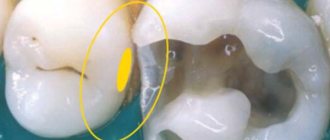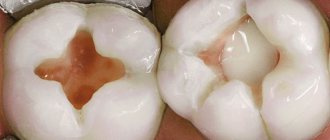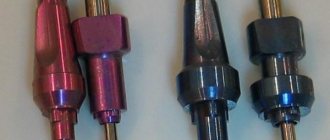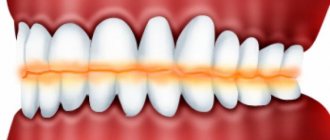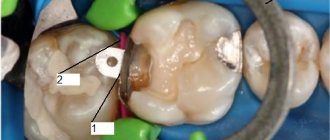2516
Dentists have a large number of different filling materials at their disposal, including the most modern ones.
So it may even seem strange that amalgam, which began to be used more than 200 years ago, is still preferred in some clinical cases. But there are reasons for this.
A little bit of history
Amalgam is the oldest filling material. The first mention of it in this capacity is in ancient Chinese manuscripts. In Europe, amalgam was first used for filling carious cavities by the French dentist Tavean in 1800.
Due to its valuable properties for filling materials - plasticity at room temperature immediately after preparation and subsequent hardening , amalgam was enthusiastically received by dentists. Even the presence of mercury in it did not negatively affect the popularity of the new material.
Despite its “antiquity,” amalgam continues to be used in dentistry today.
The use of the material is considered appropriate for filling fissures and contact surfaces of chewing units (cavities I and II classes according to Black), as well as cervical zones of the vestibular surface of all teeth (V class according to Black).
Application of amalgams
The area of application of amalgam is determined by the metal that is dissolved in it. For example, gold amalgam is an excellent gilding, so it is used to coat metal products with gold and make fluorescent, energy-saving and induction lamps. Alkali metal amalgams exhibit strong chemical activity, and therefore have found their use as reducing agents. Ores processed with mercury yield almost the entire composition of rare earth elements.
Composition and properties of the material
Amalgam is obtained by amalgamation - dissolving metal alloys in liquid mercury to form intermetallic compounds.
Tin and silver, dissolving in mercury, form a plastic mass from which a filling is formed. Subsequently, as free mercury disappears, the amalgam begins to harden.
The hardness required to withstand occlusal loads is achieved in about a day.
Includes:
- Mercury ( Hg). The primary content is 40-53%, after amalgamation and curing - 37-48%.
- Silver ( Ag) – 65-73%. This component is responsible for many of the functions of the material - corrosion resistance, hardness, and the ability to slightly expand in the cavity being processed.
- Tin (S n) – (25-29%). Increases the speed of amalgamation, slows down curing.
- Copper (Cu). Increases strength and promotes a tight fit of the material to the edges of the cavity. The content is 2-6% in silver amalgam, up to 30% in copper amalgam, and up to 37% in high-copper amalgam.
- Zinc ( Zn) – up to 2%. Prevents oxidation, reduces fragility, improves technological properties (increases the plasticity of the material).
Properties of amalgam
- Ready for condensation no later than one and a half minutes from the start of mixing.
- Compression resistance after 60 min. – 60 MPa and above, after 24 hours – 300 MPa and above.
- Elasticity – 50-58 GPa.
- Fluidity – 0±0.2% (after complete curing).
Properties
The most important property of amalgam is the ability to obtain ultra-pure metals. To do this, mercury is distilled off, and since it has a lower boiling point than the base metal, evaporation occurs.
Another important property of amalgam is changing the chemical properties of dissolved metals, or rather, allowing them to fully express them. In amalgam, atomization of the dissolved metal occurs, which is why a dense oxide film is not formed, which prevents the surface from further oxidation. In this state, metals are very active. For example, aluminum under normal conditions has a very dense oxide film, which blocks oxygen from reaching the thickness of the metal, but in amalgam this is not the case, and aluminum greedily combines with oxygen.
Kinds
Amalgams are classified by composition (type and quantity of compounds and elements included in it) and morphology (shape and size of particles of metal alloys).
Depending on the composition, amalgam is distinguished:
- silver (copper content less than 6%);
- copper – Cu content – 12-30%;
- high-copper – 32-37%.
Amalgams containing more than 0.01% zinc are called zinc-containing.
Morphology
The packability and required condensation pressure of the material depends on the shape of the alloy particles. It could be:
- chips with a size of 150 microns or more, obtained by grinding a metal alloy on a lathe (amalgam obtained from chips is called needle or regular);
- round-shaped granules (spheres) up to 40 microns in size, obtained by spraying a molten alloy in an inert gas (amalgam prepared from such particles is called spherical);
- composition of chips and granules (mixed amalgam).
Condensation of a needle-shaped mixture requires more effort than a spherical mixture.
Development time
Depending on the time of development and use, all amalgams are usually divided into materials of the 1st, 2nd and 3rd generation.
- 1st generation formulations include silver amalgams with low copper content.
- 2nd – materials with a high copper content.
- 3rd – materials containing atomic copper.
Root canal irrigation protocol and instrumentation used.
Read here about the features of vertical condensation of gutta-percha.
At this address https://www.vash-dentist.ru/lechenie/zubyi/plombyi/profaylyi-v-stomatologii.html we offer detailed instructions on the use of profiles in dentistry.
History of origin
The first use of silver amalgam was recorded in 1826 in Paris. Seven years later, the same Parisian dentists brought the amalgam to New York. American dentists have had mixed reactions to innovation in dentistry. The main reason for the negative attitude was side effects caused by incorrect production technology. There was no single recipe for preparing amalgam - everyone was guided by their own idea of what should be included in the alloy. As a result, the final result in most cases was negative. Plus, imperfect instruments played a negative role: the use of amalgam implies careful drilling of the place for the filling, which was impossible when using a hand drill. In addition, the amalgam was mixed by simply rubbing the components with a finger in the palm of the hand. But with the development of technology and the improvement of dental instruments in the 20th century, the situation changed for the better.
Purpose of mercury
Mercury plays a dominant role in amalgam, providing its basic technological and functional properties. Thanks to its presence, immediately after mixing the material becomes plastic, allowing the formation of a filling. Subsequently, it hardens - a set of hardness necessary to absorb the chewing load.
Regarding the toxicity of mercury, many studies have been conducted to determine the dangers of amalgam fillings and mercury vapor to patients and medical personnel.
It was revealed that this danger is real, but it should not be overestimated. A small amount of mercury contained in fillings can penetrate the human body.
But even if there are several fillings, its quantity is so small that it cannot cause significant harm to health. The Hg vapor density above the filling does not reach 0.04 MAC.
Medical personnel working with amalgam and coming into contact with mercury vapor are at much greater risk. However, for them, the threat of mercury intoxication can be minimized by strictly observing the prescribed work rules.
This danger becomes completely negligible when using the most modern form of amalgam - capsule. The use of capsules, in which powder and mercury are in the required ratio, eliminates contact of medical personnel with mercury.
Peculiarities
- The presence of mercury in the composition is still the subject of debate among scientists and doctors about the harm it causes to the body, although the maximum amount of mercury released in the presence of up to ten amalgam fillings in the mouth does not exceed the permissible level of the presence of liquid metal in the body;
- Destroys upon contact with gold particles. Even if there is no direct contact of metals, the presence of gold particles entering the saliva from gold crowns is sufficient to begin the destructive process;
- High thermal conductivity;
- In some cases, tooth enamel may darken.
In our country, amalgam is practically not used. But abroad, especially in government institutions where treatment and maintenance are free within the budget, it is still used. The fact is that amalgam fillings are very economical and last a lifetime. The process of mixing such fillings completely eliminates the human factor. The machine measures the components down to the microgram and mixes them too. The ready-made plastic mass is delivered to the dentist. In addition, those who are afraid of mercury poisoning should be reassured: amalgam releases more silver than this liquid metal, hence its disinfecting properties that act throughout the entire oral cavity.
Stages of filling
The process of placing an amalgam filling consists of preparatory and basic work.
Preparatory work
- Teeth cleaning.
- Anesthesia.
- Installation of rubber dam.
- Cavity preparation. The shape is classic, box-shaped, with right angles between the walls and the bottom.
It is advisable to have a greater wall thickness than when filling with composite materials.It is recommended to make a cut along the enamel-dentin border to increase retention. Finishing is performed (removal of the edges of the enamel overhanging the dentin).
- Flushing.
- Drying.
Main works
Gasket application. It is considered necessary due to the increased thermal conductivity of amalgam - in order to avoid temperature sensitivity of the tooth.
Laying can be done with different materials (zinc phosphate cements, compomers, glass ionomers, special varnishes). Thickness – 1-1.5 mm. In case of a deep cavity, it is recommended to apply a calcium-containing pad at the point where the pulp is closest to the pulp.
Mixing amalgam
The composition is mixed manually or mechanically, using electric amalgam mixers. Mixing time depends on the composition, particle shape, and mixing system used, and is 15-60 seconds.
Sealing
The material is applied in small portions with an amalgam gun (canal filler), with each portion being completely condensed before adding a new one. Particular attention is paid to preventing porosity of the filling and removing excess mercury .
Condensation is carried out with a plugger from the center to the walls of the cavity. The required pressure force is 30-40 N. It is necessary to fill the cavity with a slight excess . After filling, preliminary modeling of the tooth surface is performed and excess amalgam is removed.
During the final modeling, dimples and transverse fissures are created. The surface is smoothed with benisher. Occlusion is controlled using occlusion paper.
Grinding and polishing are carried out a day later using carborundum heads, brown and green silicone polishers.
For approximal surfaces, strips or phloxes with polishing paste are used. Polishing is done from the center to the edges of the filling. It is necessary to avoid overheating it to prevent evaporation of mercury, using water cooling if necessary.
Correct closure of a problem cavity has:
- the exact shape of the tooth crown;
- mirror shine;
- absence of a boundary between the material and the tooth.
Features of filling
The procedure for filling with amalgam is simple, so it can be completed in one session. Below are the main stages of this process.
Table. Filling teeth with amalgam.
Stage, photoDescription
| Surface preparation | The doctor prepares the carious cavity, during which a special lining made of dental cement and varnish is applied. Further work is possible only after the gasket has hardened. |
| Grinding in amalgam | The second step involves applying a small amount of amalgam to the spacer, which serves to separate the tooth from the filling. With gentle movements, the material rubs against it. |
| Amalgam condensation | After the first layer of material has been applied, it is condensed. This procedure will allow you to separate the most liquid part of the material. |
| Occlusion check | During the examination, the dentist examines the relationship of the teeth taking into account the installed filling. The patient should not experience any discomfort when clenching the jaw, and this stage helps with this. |
| Complete hardening | It may take 5 to 8 hours for an installed amalgam filling to harden completely. During this period, the patient is not recommended to eat solid food, and within 2 hours after the procedure, to refuse food completely. |
The dentist may not begin polishing and grinding the installed filling immediately, but only after 24 hours. Otherwise, the material may be damaged or deformed, so all stages of filling will need to be started all over again.
Possible consequences
If the filling technique is performed incorrectly, for example, during mixing of the composition or if the protocol is violated, complications may arise. First of all, when using amalgam, secondary caries may develop.
This is interesting: Removing tartar in dentistry: how does ultrasonic teeth cleaning work, is it painful?
It occurs due to insufficiently tight fit of the filling around the edges. If the filling material does not adhere well to the patient's tooth, then a small gap will form in this place through which food particles can enter.
Over time, a large amount of microflora and food will accumulate in this microscopic gap, which, in turn, will lead to caries.
Note! In rare cases, after filling with amalgam, an allergic reaction occurs, but its development, as a rule, is facilitated by the patient’s increased sensitivity to a particular component of the product used.
Amalgam fillings are considered durable, so once successfully filled they will last at least 5 years before needing to be replaced. Like other types of fillings, dental amalgam is subject to a small degree of dissolution and deformation.
Therefore, in order for the product to last longer, experts do not recommend subjecting it to excessive loads. If you like crackers, nuts or other hard foods, then try to limit their consumption or at least chew on a tooth that is not filled.
All the pros and cons
Modern amalgams are free from many of the disadvantages of 1st and 2nd generation materials. Among their advantages:
- high ductility with sufficient hardness;
- tight marginal adhesion;
- stability of properties under the influence of oral fluid and hygiene products;
- corrosion resistance;
- low allergenicity;
- inertia regarding tooth shade;
- high bactericidal activity;
- insignificant expansion and shrinkage;
- Duration of maintaining a smooth, shiny surface.
Flaws
- A color different from the color of the tooth enamel (silver). Therefore, from an aesthetic point of view, it is advisable to fill only chewing teeth with amalgam.
- High thermal conductivity. If the lining is missing or insufficiently thick, the teeth may become sensitive to hot and cold.
- Changes in size due to shrinkage and expansion at different stages of filling. For good retention, it is desirable that the material expands slightly at the end of curing.
- The difference in the parameters of thermal expansion of amalgam and dentin (possible destruction of the thin wall of the teeth due to thermal expansion).
- Lack of a chemical bond between the filling and the tooth.
- Presence of toxic mercury.
- The occurrence of electric current (galvanic syndrome) in the presence of metal orthodontic or orthopedic structures in the oral cavity. It manifests itself as a metallic taste in the mouth, a feeling of acidity, and a burning sensation on the tongue.
- The time interval between the formation of the filling and the time of final curing is too long (about a day).
It can be reduced with appropriate additives, but at the cost of reducing working time to 4-5 minutes, which is not always advisable.
Composition and properties of Atatsamit cement, rules of use for canal filling.
In this publication we will discuss the lateral condensation method for filling root canals.
Follow the link https://www.vash-dentist.ru/lechenie/zubyi/plombyi/obturatsiya-kornevyih-kanalov.html if you are interested in the intricacies of the root canal obturation method.
Preparation of amalgams
The classic method of producing amalgam is to wet the metal with mercury, but in this case the formation of the latter can only occur on a metal that does not have an oxide film, for example, gold. It instantly forms a solution in mercury. Therefore, the electrochemical method is more widely used. In it, on a mercury cathode, metal cations are reduced to pure metal, which instantly forms an amalgam.
The oxide film can be removed with acid and then treated with mercury. This is the case with aluminum. There is another interesting method, which is based on the cementation process. Powdered metal with a lower value of the standard electrode potential is supplied to the mercury salt solution. Liquid mercury is released on the surface of the metal particle, which interacts with the remaining metal.
Limitations and possible consequences
Contraindications to amalgam fillings include the patient’s sensitivity to the components of the material , in particular mercurialism (mercury intoxication). As well as metal devices present in the mouth (dentures, crowns).
All other contraindications are relative, and are usually associated with the emotional attitude of the patient himself to the filling material. The reason may be an exaggerated, not always justified fear of mercury poisoning, or a reluctance to have a shade on the teeth that is different from the teeth.
AMALGAM
The first publications about the use of amalgam date back to 1601. It was widely used. Up to 200 million North Americans have amalgam fillings. Up to 38 million fillings were installed in Germany every year. From the 1970s to 1980s, amalgam was banned from use in dental settings. Beginning in the 80s, for 15 years, there was a discussion about the possibility of using amalgam in dentistry. The reason for the discussion was multiple publications regarding the toxic effects of amalgam.
In Sweden, museum workers discovered mercury in the feathers of birds. It was found that the birds migrated from the area where the plant was located, the work of which is associated with acetaldehyde and mercury (Japan). Birds pecked at grain containing mercury, consuming the latter in their feathers. On June 1, 1993, amalgam was banned in Sweden, and subsequently a ban on amalgam was introduced in other countries around the world.
In this regard, Germany conducted a longitudinal (20 years) study to determine the toxic effect of amalgam fillings on dental workers. It has been proven:
1. Dentists working with amalgam do not have mercury in the tissues of hair and nails. This was explained by the use of capsules, amalgators, and amalgam mixers.
2. The health of the patients did not change after removal of the amalgam restorations.
3. The mortality rate of people working with mercury and having amalgam fillings did not exceed the statistical average.
In Germany, only copper amalgam with a high content of γ2 phase was banned. In Russia, copper amalgam was prohibited for use in children under 6 years of age and pregnant women (traces of mercury were found in the placenta and embryos).
Sweden has also conducted a survey on mercury accumulation from amalgam fillings. 8157 children of dental workers were examined (dentists - 1360; nurses - 6340; technicians - 457). There were no miscarriages, no stillbirths, and no deformities were noted. Conclusions were drawn:
1. Mercury in fillings does not cause systemic diseases and does not have a toxic effect on their owners.
2. Mercury does not affect the immune response.
3. Allergic reactions to amalgam fillings do not exceed those to gold.
4. There was no teratogenic effect of amalgam fillings.
However, now in Europe and America the era of the rebirth of amalgam has begun.
Until recently amalgam was the best filling material used for chewing teeth. Amalgam can be used in patients of any age, regardless of the severity of caries and their hygienic status.
Amalgam is an alloy of mercury with one or more metals (an alloy of silver, copper, tin). When mercury is mixed with metal particles, ductile, quickly hardening alloys are formed. This process is called amalgamation.
Depending on the amount of metals, amalgams are divided into simple and complex. Simple amalgams consist of two components. Complex ones include three or more components.
In addition to mercury, they may include silver, tin, copper, and zinc. During the amalgamation process, metals enter into chemical reactions with mercury, forming intermetalloids that ensure hardening of the filling. The base of amalgam is most often silver - silver amalgam and copper - copper amalgam.
Copper amalgam , which disappeared from our clinics for several years, has returned again in the form of CMTA-56. Copper amalgam
It is a solution of copper in metallic mercury and is produced in the form of small pressed square tiles.
Composition of copper amalgam:
copper - 32 - 37%;
mercury - 59 - 66%;
zinc - 2 - 4%.
Zinc is added to reduce the compressibility of the filling, improve the fixation of mercury in the filling and color stability. Mercury is a solvent for copper and zinc. Since copper is relatively poorly soluble in mercury, it is obtained electrolytically, by precipitation from a copper sulfate solution. Such copper reacts well with mercury, and therefore copper amalgam is plastic, changing its shape and volume little after insertion into the cavity. The last circumstance is important, because a filling made of copper amalgam does not lag behind the edges of the cavity, which, as is known, is one of the important requirements for filling materials. In addition, copper amalgam fillings have significant strength.
Copper amalgam also has a number of negative properties:
1) does not adhere to the walls of the cavity;
2) stains the tooth tissue in a dark color;
3) has good thermal conductivity;
4) hardens slowly;
5) causes corrosion of gold crowns due to the presence of mercury, which can be released from the filling;
6) less resistant to chemical influences when filling gingival cavities.
Some of the indicated disadvantages of copper amalgam (in particular, the ability to color hard tooth tissues and conduct heat well), if not completely eliminated, are weakened by the application of a full-fledged insulating lining made of zinc phosphate cement. In addition, by thoroughly washing the amalgam with water and ammonia, you can wash copper amalgam from oxides and thereby reduce the staining of dental tissues.
To prepare filling material from copper amalgam, two or three squares or more (their number depends on how many fillings the filling material is being prepared for) are heated in a special spoon over the flame of an alcohol or gas burner at a temperature of 240 - 260 ° C.
At the same time, the mercury expands and loosens the amalgam. After small droplets of mercury appear on the surface (this usually happens 5 - 10 s after heating), the heated amalgam is transferred to a glass mortar and thoroughly, forcefully rubbed for 2 minutes with a pestle until a homogeneous plastic mass is formed (Fig. 10.28).
It should be noted that overheated or underheated amalgam loses its qualities and is not suitable for use. Overheating the amalgam significantly increases the time it takes to set. Overheated amalgam easily breaks into small pieces. Underheated amalgam remains hard and is not crushed with a pestle.
Warming and rubbing of the amalgam should be carried out for 2 - 4 minutes in a fume hood.
When grinding, the mortar should be kept on the table and not suspended. To prevent mercury from getting on the floor and table, the mortar should be installed in an enamel tray.
Copper amalgam must be washed especially thoroughly with alkaline water to remove metal oxides. To do this, add 5-6 drops of ammonia or 0.5 g of soda to one glass of water.
Of great importance for the quality of the future amalgam filling is the maximum removal of excess mercury from the copper amalgam, which is achieved by squeezing the mercury out of the amalgam using suede or through a gauze cloth. If, after squeezing out the mercury, the amalgam becomes insufficiently plastic, it should be ground again with a pestle in a mortar. The prepared amalgam should be stored in damp gauze in a jar with a ground stopper. The beginning of amalgam setting should be considered the moment when the shiny surface of the ball changes to matte. The beginning of hardening or crystallization of amalgam is considered to be the moment when the amalgam, having lost its plasticity, does not yield again to efforts to roll it into a ball.
Copper amalgam is used to fill carious cavities in molars and premolars. Due to its plasticity, ability to maintain shape and volume, and not to change its properties in conditions of high humidity, amalgam has found wide use in dental treatment for children.
Currently, almost all countries use silver amalgam with a significant addition of copper - “high-copper amalgam”.
This material can be produced in capsules, greatly simplifying compliance with safety measures. Copper amalgams consist of copper and mercury, with small additions of silver and tin.
Advantages:
The material is very plastic, provides a good marginal fit, and has an anti-caries effect.
Flaws:
At the same time, copper amalgam stains tooth tissue black due to the presence of copper sulfides. This drawback negates all the advantages of the material.
The filling technique and precautions when working with them are the same as when working with silver amalgams.
Currently, copper amalgam “SMTA-56” is produced in limited quantities in Russia in capsules. Her “working time” is 6-8 minutes.
Chemically, amalgation proceeds as follows (Petrikas A.Zh., 1994):
Ag3Sn + Hg ® Ag2Hg3 + Sn7Hg8 + Ag3Sn
γ γ1 γ2 γ
This chemical reaction is achieved by grinding sawdust and mercury in a mortar or mixing the ingredients in amalgam mixer capsules. Excessive amounts of mercury, prolonged mixing of sawdust with mercury, repeated mixing of amalgam, weak condensation lead to the accumulation of the γ2 phase in the filling, which reduces the corrosion resistance and strength of the material. The presence of zinc in the gasket material, in combination with the γ-phase, results in an increase in volume and corrosion of the filling.
During amalgamation, copper actively competes with tin for mercury, forming the h phase - Cu6Hg5, depriving it of the γ and γ1 phases.
2Ag3 Sn + 3Cu3 Sn + 8Hg ® 2Ag3 Hg4 + Cu6 Hg5
Sawdust alloy mercury filling
Composition and properties of amalgam. Copper and silver amalgam are currently used in dental practice.
Removal and replacement
Proper recovery involves removal and disposal as complete as possible. In this case, the filling is not drilled out, but cut with a cross-shaped incision and removed in pieces.
Instead of diamond burs, cutters made of tool steel are used. A rubber dam is placed around the treated area to prevent particles from entering the oral cavity.
When removing, special oral suction and filtration systems are used.
The windows in the office must be kept open during the procedure.
The filling particles are collected in a special container and disposed of according to established rules.
It is not recommended to remove the filling during particularly vulnerable conditions, which include pregnancy and breastfeeding.
A patient who is planning to replace an old filling material is recommended to take activated charcoal immediately before the procedure (to bind mercury particles). And a few hours before removal - vitamin C.
The video provides additional information on the topic of the article.
Use in mining[edit]
Mercury was used in gold and silver mining because of the convenience and ease of combining mercury and precious metals. In placer gold mining, in which tiny particles of gold are washed out of sand or gravel deposits, mercury was often used to separate the gold from other heavy minerals.
After all the practical metal had been extracted from the ore, the mercury was distributed over a long copper bath, which formed a thin layer of mercury on the outside. The waste ore was then moved into a chute and the gold in the waste was combined with the mercury. This coating was then scraped off and purified by evaporation to remove the mercury, leaving behind high purity gold.
Mercury amalgamation was first used on silver ores with the development of the patio process in Mexico in 1557. There were also additional amalgamation processes that were created to process silver ores, including panel amalgamation and the Washoe process.
Gold amalgam[edit]
Gold mining (mining) [edit]
Gold amalgam has proven effective where fine gold ("flour gold") cannot be recovered from the ore using hydromechanical methods. Large amounts of mercury were used in placer mining
, where deposits consisting primarily of decomposed granite slurry were separated by long rows of "rotor boxes", with the mercury being dumped at the start of the journey. The resulting amalgam is a heavy, solid mass of dull gray color. (The use of mercury in placer mining in California in the 19th century, now banned, caused serious pollution problems in rivers and estuaries that continue to this day. Sometimes downstream rivers and stream bottoms, amateur miners wear wet suits search for gold nuggets using a water vacuum/dredge driven by a motor mounted on a float.
Gold mining (ore processing) [edit]
Interior of the Deadwood Terra gold stamp factory. The crushed ore is washed off the mercury coated copper sheets and the fine gold particles form an amalgam with the mercury. The amalgam was scraped off and then the gold was separated from the amalgam by heating and evaporating the mercury, which was then collected by a condenser to be reapplied to the plates.
Where stamping mills were used to grind gold ore into fines, part of the extraction process involved the use of mercury-wet copper plates over which the ground fines were washed. Periodic scraping and repeated mercury treatment of the plate produced an amalgam for further processing.
Gold mining (objection) [edit]
The amalgam produced by either method was then heated in a distillation retort, extracting the mercury for reuse and leaving the gold. Because it releases mercury vapor into the atmosphere, the process can cause adverse health effects and long-term pollution.
Today, mercury amalgamation has been replaced by other methods of extracting gold and silver from ore in developed countries. The hazards associated with toxic mercury waste have played an important role in the abandonment of mercury amalgamation processes. However, mercury amalgamation is still regularly used (often illegally) by small-scale gold miners, especially in developing countries.
Reviews
Amalgam filling is not such a common dental service these days. Most dentists prefer to use more modern filling materials.
Therefore, the experience of using an amalgam filling is of increased interest to other patients. If you have such a filling, tell us about your impressions of it in the comments at the bottom of this page.
If you find an error, please select a piece of text and press Ctrl+Enter.
Tags treatment filling fillings
Did you like the article? stay tuned
Previous article
Smile design - an individual approach at a modern level
Next article
Is it possible to save a tooth with hypertrophic pulpitis?
Advantages of amalgam fillings
In our country, fillings are not made from this material. Meanwhile, in the West they are very widely used in public free dental clinics. The main advantage of amalgam fillings is their durability. In the vast majority of cases, they last as long as the tooth itself.
The low cost of the material is undoubtedly also its advantage, especially since in our time the mixing of alloy components is done by robotics, not humans. The dentist receives a mass ready for use at his disposal. The presence of a large amount of silver in the material completely neutralizes the effect of mercury.
Cons of amalgam fillings
- low aesthetics: their color is the same as metal crowns - gray, shiny. Plus, it will not be possible to recreate the natural anatomy of the tooth with all the tubercles and cavities from the material, down to the smallest detail,
- limited application possibilities: mainly chewing teeth are filled, again due to the external unattractiveness of the material,
- the need to prepare a large cavity before installation,
- lack of adhesion, poor marginal fit, poor tightness: amalgam is one of the budget and wear-resistant solutions in dentistry, but the most common indications for its replacement ahead of schedule is the occurrence of secondary caries[2],
The downside is that the fillings do not fit tightly to the tooth.
- increased dental hyperesthesia, thermal injuries and, as a consequence, the development of pulpitis and periodontitis are possible: metals conduct heat well,
- the risk of developing side effects and negative reactions of the body,
- in the presence of amalgam and the installation of other metal structures (crowns, braces) in the oral cavity, there is a possibility of developing galvanic syndrome,
- the appearance of chips and cracking of tooth walls: the material has a high expansion coefficient,
- discoloration of the walls of the filled tooth in a grayish color.
